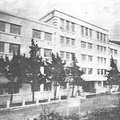>> Part 1
V. “Granny’s Dance” and Folk Dance: A Japanese European Comparison
Having first observed the Paraná Folklore and Ethnic Festival in the early 1980s, I was shocked by something in particular. I believe that everyone who was there felt the same way I did. I saw that the European groups had many child participants and that the young men and women wore traditional costumes. They performed their folk dances very beautifully and at times even acrobatically. In comparison, with the Nikkei group, middle-aged and elderly Japanese women performed Japanese traditional dance and music. And although they performed gracefully with skill, it was quite slow. The differences in age, male-female ratio, and the speed of movement were apparent to everyone, and could not help but leave a strong impression. Even among Nikkei people, there were some who said “these grannies perform the same dance every year.”
When considering why such drastic differences exist, first, with Japanese dance, there is no opportunity for men and women to dance together as there is with European folk dance. It can be surmised that as a result, few young people feel particularly interested in participating in this type of dance. With European folk dance, in addition to beautiful costumes and elegant movements, there is the additional attraction of men and women holding hands and dancing together.
However, when one looks more closely at the internal circumstances of other ethnic groups, it is possible to identify one other point that differs from Nikkei. For all other ethnic groups, at least half of the participants come from other ethnic groups. Stated differently, for many of these people, performing a certain folk dance and music is appealing, and something that they feel particularly comfortable with. In the Italian group, there are German and Polish descendants participating, and in the Ukrainian group, there are Italian and Spanish participants. In reality, there were Nikkei participants in the German and Polish groups. For these participants, the dance of Italy, Ukraine, and Germany is something that they feel particularly attracted to, and comfortable with. They are very fond of the form of dance itself, and that is why they choose to perform. And within each of these groups, its members admit to the possibility of maintaining their groups through having such participants from other ethnic groups.
How then should Nikkei group that is made up almost entirely of middle-aged and elderly Nikkei women continue? In order for Nikkei group to continue to exist, and transmit their cultural traditions, it is not only necessary for them to include members of younger generations, but also transform the group so that they will be attractive to members of other ethnic groups.
The first plan devised by Nikkei community leaders to raise interest among the younger generations in the Folklore and Ethnic Festival was to invite a natori and to teach Sansei along with middle-aged Nisei and elderly Issei Japanese dance. Japanese dance was selected because this cultural form had gained popularity abroad, and there were a significant number of natori as a master qualified to teach it. In comparison, it was a reality that it was difficult to find masters of other folk art forms.
Eventually however, through the individual efforts of the natori, there emerged a group of Sansei girls who developed an interest in Japanese dance, and who began participating in the Folklore and Ethnic Festival. For these girls, just as the Brazilian Carnival is for Carioca (Rio de Janeiro residents), this festival is a once-in-a-year chance to perform, and in addition to this, this is a place where they could enjoy distinctly Japanese culture not present in the activities of other ethnic groups. This served as an important opportunity to express their identity as Japanese Brazilians as distinct from other Brazilians. And to be sure, Japanese dance costumes were beautiful and something to be proud of.
However, for these Sansei girls as well, after two or three years they were no longer satisfied with just Japanese dance. For these Sansei, who as Brazilians had grown up in an environment of Latin culture that included samba and Carnival, this Japanese dance was far too monotonous and slow. These Sansei urged their master, “Sensei, Acho que não dá,” (Teacher, this is no good) “We need something faster!” But as far as the master instructor was concerned, “these girls’ dance is not Japanese dance,” showing that there were limits to Japanese dance. And so one year, these Sansei girls decided to follow their own path, coming up with their own choreography, and presented their own type of dance. However, this could not be called a success as Japanese dance, nor unfortunately was it a Brazilian style of Japanese dance either. In either case, in reality, they were unable to find a way to express themselves according to their own ways.
VI. Encounter with Yosakoi soran and Taiko
With increased globalization, it became easier for people to connect through the exchange of information as well as the ability to purchase such items as costumes, audio tapes, videos, and CDs.
The Italian group at the Folklore and Ethnic Festival researched the history of folk dance in Italy through the Internet, and some young people studied costume and choreography, thus adding to their repertoire, while others contacted those in Italy, even visiting to learn more. Leaders of the German groups began coming together once a year, studying under a professional they would invite from Germany, and when these leaders returned to their homes, they taught members of their groups. Further, among the Polish groups, every few years a choreographer was invited from Poland to spend the year teaching the groups, and every two years groups from around the world gather together for a workshop, thus leading to lateral transmission as well. Due to these steady activities, it can be surmised that respective descendants of the immigrants develop an interest in having Italian, German, or Polish ancestry.
Globalization also influenced the Nikkei as well. “Yosakoi soran” is one such example. Through satellite television and video, “Yosakoi soran,” a new type of group street dancing, was introduced to Brazil in the late 1990s. And the result was outstanding. The Sansei were immediately taken with “Yosakoi soran.” This is because it is not only a fast-tempoed Japanese dance, but also because they were able to freely select their costumes and choreography. With “Yosakoi soran” each group, with only a little regulations, is given the freedom to create their original costumes and choreography. And more than anything, with this dance, men and women are able to dance together. There is no longer any need for men and women to feel ashamed of dancing together.
This is just the sort of dance that the Sansei girls were looking for in order to express themselves. And there was no surprise that non-Japanese Brazilians showed an interest in this type of performance. And as expected, there were soon non-Japanese Brazilian participants.
This same type of phenomenon could be observed in the 1970s in North America with taiko. With Japanese drumming brought over by Japanese as the base, a distinctly North American style of taiko was formed, with Japanese American Sansei forming the center of the groups. Of these, there are groups that express their Japanese American or Japanese Canadian identities, as well as groups that use taiko to serve as the foundation for community activities centered on traditional Japanese culture.
In South America, it was only recently that taiko became popular or came to be ascribed with such meaning. In Brazil, through instruction by masters from Japan, taiko has risen in popularity, and in 2004, a Brazilian Association of Taiko was established. In the future, it can be anticipated that taiko will become the kind of cultural phenomenon it is in North America. Also at the individual level, it goes without saying that there are those who find sense of self as Japanese Brazilians or their identity as Nikkei, through taiko.
There are several reasons in common for Yosakoi soran and taiko to gain such popularity among young Nikkei. Both of their roots are in Japanese culture, but at the same time they have a certain spirituality and originality. In other words, both require consistent discipline, but are also characterized by the flexibility to devise unique choreography and rhythms. Through this, participants are able to construct their identity as Nikkei, and express it publicly. Seen from a different perspective, Nikkei is not something that one is born with, but something that came to be achieved through great effort. At this point, people are not born as Nikkei, but it is only through acquisition of Nikkei culture that one becomes Nikkei.
VII. To be Nikkei
When interviewing the second and the third generations of the Japanese immigrants in the field, I often come across a certain ambiguity and vagueness in the way they describe their identity. They are neither Japanese nor Brazilian. They confess a certain inbetween-ness they experience as they walk the line between these two identities. Different people express this in different ways, so that some say, “I am half Japanese and half Brazilian,” while others cram everything into the answer, “I am Japanese Brazilian.” However, it is worth noting that since the late 1990s, there have emerged the second and the third generations who state without hesitation, “I am Nikkei.”
In this case, Nikkei written in alphabet contains a different meaning from Nikkei as rendered in kanji as used in Japan. Nikkei, as rendered in kanji, connotes a label expediently by Japanese people in Japan. Among Nikkei themselves, however, there are many who resist being placed within the Nikkei category. Nikkei in alphabet used here is something defined by Nikkei themselves and unique to them—even though only one part of the whole—in order to declare their own identity/selves. And further, this contains something that transcends an innate and passive meaning of lineage and includes a more active connotation of acquiring. In America as well, there are people who use Nikkei as something distinct from “Japanese American,” ascribing to it a more original and inclusive meaning.
With greater globalization, there have been more opportunities for Nikkei in different countries to connect with one another. Starting with Convention of Nikkei and Japanese Abroad and Convention of Pan-American Nikkei, there are also cases where Japanese Americans and Japanese Brazilians have met in Japan and have co-sponsored parties. Through such opportunities, these Nikkei find that they have much in common outside of nationality, and identify the things they have in common as what defines Nikkei-ness.
Such phenomena signal the arrival of a new Nikkei era, and further demonstrate the central place of cultural traditions such as dance and taiko. And as for the future of these art forms, as they become things that can be fully appreciated by non-Nikkei, so that these non-Nikkei also participate and transmit these traditions, Nikkei culture will be carried on. This new generation of Nikkei’s voices will be heard, writing a new page to the history of Japanese immigrants.
References
Akemi Kikumura-Yano, editor, Amerika tairiku nikkeijin hyakka jiten (Encyclopedia of Japanese in the Americas) (Akashi Shoten, 2002)
Imin Kenkyukai, editor, “Senso to Nihonjin Imin” (Toyo Shorin, 1997)
Harumi Befu, editor, “Nikkei Amerika Jin no Ayumi to Genzai” (2002)
Shuhei Hosokawa, “Sanba no Kuni ni Enka ha Nagareru” (Chuko Shinsho, 1995).
* This article was originally published in Nanboku Amerika no Nikkei Bunka (Jimbun Shoin).
© 2008 Shigeru Kojima






